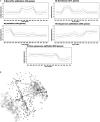Transcriptional analyses of Barrett's metaplasia and normal upper GI mucosae
- PMID: 11896567
- PMCID: PMC1550324
- DOI: 10.1038/sj.neo.7900221
Transcriptional analyses of Barrett's metaplasia and normal upper GI mucosae
Abstract
Over the last two decades, the incidence of esophageal adenocarcinoma (EA) has increased dramatically in the US and Western Europe. It has been shown that EAs evolve from premalignant Barrett's esophagus (BE) tissue by a process of clonal expansion and evolution. However, the molecular phenotype of the premalignant metaplasia, and its relationship to those of the normal upper gastrointestinal (GI) mucosae, including gastric, duodenal, and squamous epithelium of the esophagus, has not been systematically characterized. Therefore, we used oligonucleotide-based microarrays to characterize gene expression profiles in each of these tissues. The similarity of BE to each of the normal tissues was compared using a series of computational approaches. Our analyses included esophageal squamous epithelium, which is present at the same anatomic site and exposed to similar conditions as Barrett's epithelium, duodenum that shares morphologic similarity to Barrett's epithelium, and adjacent gastric epithelium. There was a clear distinction among the expression profiles of gastric, duodenal, and squamous epithelium whereas the BE profiles showed considerable overlap with normal tissues. Furthermore, we identified clusters of genes that are specific to each of the tissues, to the Barrett's metaplastic epithelia, and a cluster of genes that was distinct between squamous and non-squamous epithelia.
Figures


Similar articles
-
Mucin gene expression and cell differentiation in human normal, premalignant and malignant esophagus.Int J Cancer. 2000 Dec 15;88(6):856-61. doi: 10.1002/1097-0215(20001215)88:6<856::aid-ijc3>3.0.co;2-d. Int J Cancer. 2000. PMID: 11093805
-
Cdx1 and c-Myc foster the initiation of transdifferentiation of the normal esophageal squamous epithelium toward Barrett's esophagus.PLoS One. 2008;3(10):e3534. doi: 10.1371/journal.pone.0003534. Epub 2008 Oct 27. PLoS One. 2008. PMID: 18953412 Free PMC article.
-
Increased CDX2 and decreased PITX1 homeobox gene expression in Barrett's esophagus and Barrett's-associated adenocarcinoma.Surgery. 2005 Nov;138(5):924-31. doi: 10.1016/j.surg.2005.05.007. Surgery. 2005. PMID: 16291394
-
Molecular mechanisms of Barrett's esophagus.Dig Dis Sci. 2011 Dec;56(12):3405-20. doi: 10.1007/s10620-011-1885-6. Epub 2011 Oct 8. Dig Dis Sci. 2011. PMID: 21984436 Free PMC article. Review.
-
The diagnosis and management of Barrett's esophagus.Adv Surg. 1999;33:29-68. Adv Surg. 1999. PMID: 10572561 Review.
Cited by
-
cDNA microarray analysis of esophageal cancer: discoveries and prospects.Gen Thorac Cardiovasc Surg. 2009 Jul;57(7):347-56. doi: 10.1007/s11748-008-0406-9. Epub 2009 Jul 14. Gen Thorac Cardiovasc Surg. 2009. PMID: 19597924 Review.
-
miR-200 family expression is downregulated upon neoplastic progression of Barrett's esophagus.World J Gastroenterol. 2011 Feb 28;17(8):1036-44. doi: 10.3748/wjg.v17.i8.1036. World J Gastroenterol. 2011. PMID: 21448356 Free PMC article.
-
Barrett's oesophagus and oesophageal adenocarcinoma: time for a new synthesis.Nat Rev Cancer. 2010 Feb;10(2):87-101. doi: 10.1038/nrc2773. Nat Rev Cancer. 2010. PMID: 20094044 Free PMC article. Review.
-
Short-segment Barrett's esophagus and cardia intestinal metaplasia: A comparative analysis.World J Gastroenterol. 2010 Dec 28;16(48):6151-4. doi: 10.3748/wjg.v16.i48.6151. World J Gastroenterol. 2010. PMID: 21182233 Free PMC article.
-
Barrett's Esophagus: Emerging Knowledge and Management Strategies.Patholog Res Int. 2012;2012:814146. doi: 10.1155/2012/814146. Epub 2012 May 30. Patholog Res Int. 2012. PMID: 22701199 Free PMC article.
References
-
- Levine DS, et al. Specialized metaplastic columnar epithelium in Barrett's esophagus. A comparative transmission electron microscopic study. Lab Invest. 1989;60(3):418–432. - PubMed
-
- Levine DS, et al. Correlation of ultrastructural aberrations with dysplasia and flow cytometric abnormalities in Barrett's epithelium. Gastroenterology. 1989;96(2 Pt. 1):355–367. - PubMed
-
- Moore JH, et al. Intestinal differentiation and p53 gene alterations in Barrett's esophagus and esophageal adenocarcinoma. Int J Cancer. 1994;56(4):487–493. - PubMed
-
- Regalado SP, et al. Abundant expression of the intestinal protein villin in Barrett's metaplasia and esophageal adenocarcinomas. Mol Carcinogen. 1998;22(3):182–189. - PubMed
-
- Wu GD, et al. Sucrase-isomaltase gene expression in Barrett's esophagus and adenocarcinoma. Gastroenterology. 1993;105(3):837–844. - PubMed
MeSH terms
Substances
LinkOut - more resources
Full Text Sources
Other Literature Sources
Medical
